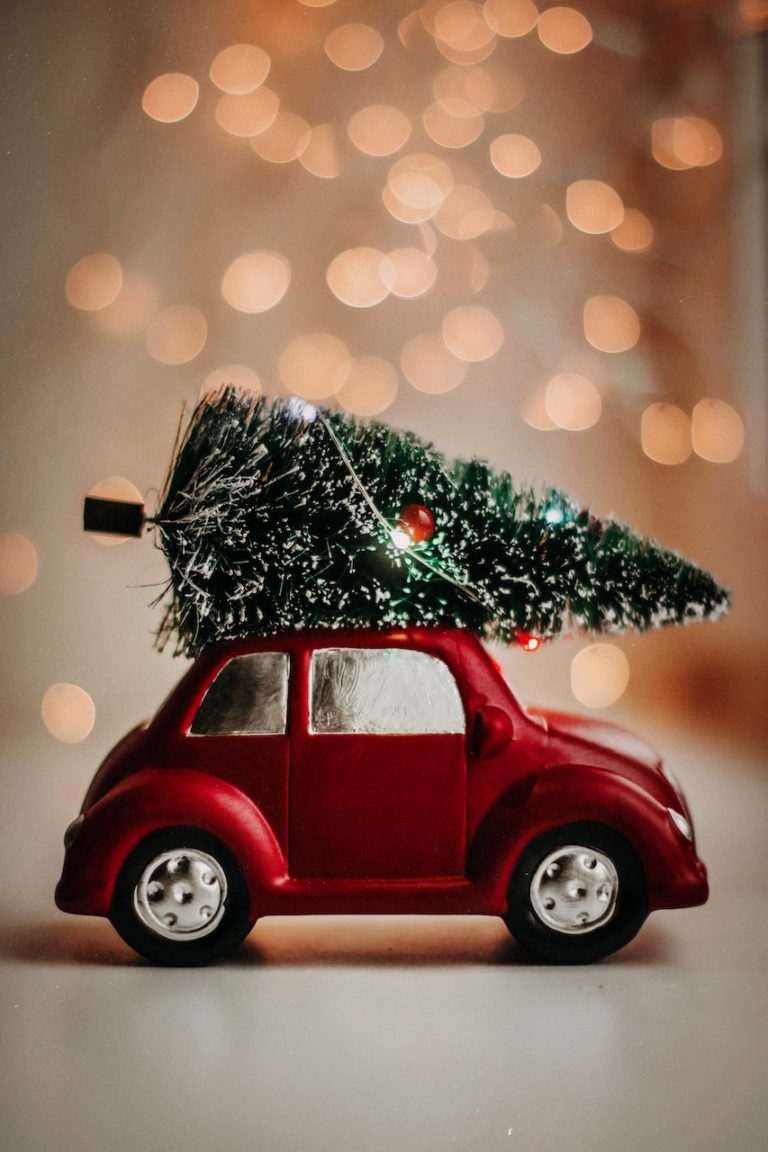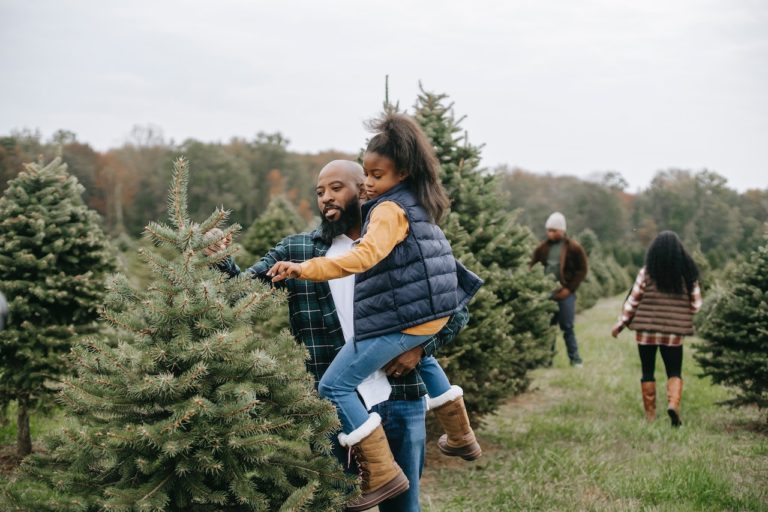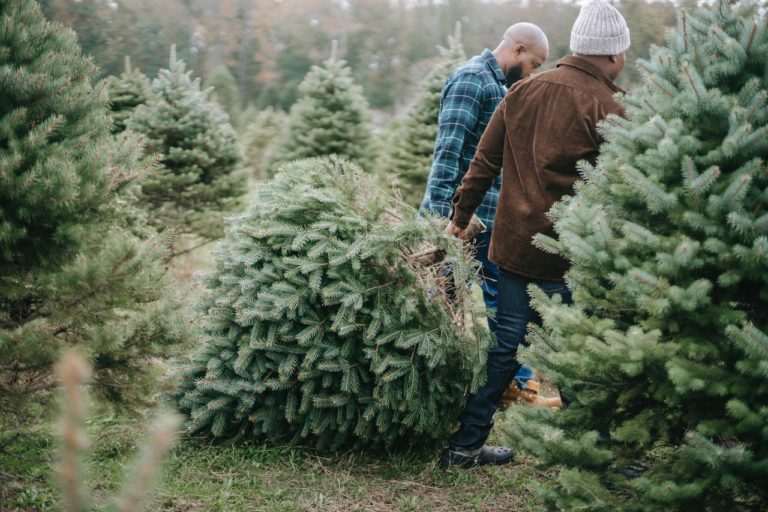‘Tis the season to be sustainable! Christmas time is nigh and you might be thinking about getting your Christmas tree soon. If you have a eco-friendly mindset you might be wondering which kind of Christmas tree is the greenest?
Is it more sustainable to get real Christmas trees or fake Christmas trees? Let’s find out together.
The official crowned winner for the most sustainable Christmas tree is a real Christmas tree. But there are some simple things you could accidentally do that make an artificial tree a more sustainable choice for you. And spoiler alert, I name my own winner in the end too.
Fake vs. real isn’t the only consideration you could be making either. Beyond those two traditional choices, you could also check for a local tree service. Some services out there deliver and pick up real, living Christmas trees and keep them alive from year to year. And last, some people DIY their tree. You could cut a tree down yourself or make one at home.
Clearly, there’s a lot of options here and they come with their own pros and cons. You might find that a fake tree is most sustainable for you while a real tree is most sustainable for your neighbor. This post will cover each of the choices I’ve mentioned and help you make the best choice for your home this holiday season.

Real Christmas Trees
Let’s start with a live Christmas Tree. My family was never one to visit a farm each Christmas season. We didn’t pick out the perfect one, chop it down, and proudly carry that tree home atop our family van. But many of you did, and still do. It’s a beloved tradition for you.
Real Christmas trees also bring a wonderful fragrance into your space. As someone who loves a good scent in my home I can understand the appeal. Bundled with the satisfaction of having worked for that tree while possibly supporting a local business, they make a great case for winner here. However, there are some setbacks to real Christmas trees too.
Real Christmas trees come from tree farms, and sometimes those farms can replace native vegetation. That can be harmful to a local ecosystem even though the farm might be absorbing carbon. The native forest would have already been absorbing carbon but it would have been doing it with a more diverse population.
That is to say, without the farm, the land might have a bunch of plants and animals living there, but instead it now is home to one species of tree and a few creatures. That is called a monoculture and it’s not a good thing for the planet.
Many farms also use pesticides, fertilizers, and other treatments to help their crop yield. All of those things impact the environment as well.

Fake Christmas Trees
Like I said, my family used fake trees (with the exception of one year). My tradition wasn’t picking the very best and dragging it home, it was unboxing, piecing together, and arranging the branches just right! And we did that year after year, the weekend after Thanksgiving, which brings me to the pros of a fake tree.
One common argument for fake Christmas trees is that they can be reused year after year. That’s true. Another benefit is that they aren’t replacing any native plant species on farms so local systems remain intact.
Most people probably pick their fake trees up at a big box store, but another great thing about fake trees is that you can get them second hand! That would actually be the most sustainable choice if you’re looking at fake trees with heart eyes.
You’re reducing the need on the market for new artificial trees and extending the life of one that was already purchased.
But fake trees come with negatives, sadly. For starters, fake trees are often made with PVC which is a kind of plastic called polyvinyl chloride. It’s extremely common…but it’s known for polluting the planet during its creation, usage, and disposal.
As if it couldn’t get worse, fake trees also have to travel much further than your typical real tree. That’s because many fake trees are manufactured overseas, shipped on cargo ships, trucked to a store, and then driven home by you and your loving family. And unlike real trees, these can’t be composted, so end-of-life treatment is a barrier to achieving sustainability.

Reusable Live Christmas Trees?
An alternative I’ve seen recently is to have a live tree delivered to you and then collected after the holidays. These living trees are taken care of and kept alive after the holiday season, only to be reused next year. This brief article covers two companies in New York that do this.
This concept brings a whole new meaning to the tradition of Christmas trees and I love the potential. It sounds like a great alternative to the one-and-done nature of traditional real trees. It also seems like it remedies the material concerns we have about fake trees.
And maybe these new trees are a great solution. But to be honest, I don’t know. These are new methods and some of the key research for the real vs. fake tree debate comes from 10 years ago. So without serious research on this new method, it’s hard to compare the impact of delivering live trees to buying artificial and traditional real trees.
But, some things I would like to note here are that this method still replaces native species. It likely includes pesticides and other chemical treatments, and the delivery process emits carbon. Those might be equal to a traditional real tree, but without research we can’t be sure. So for now, you’ll have to make a decision with this kind of tree without strong guidance from science.
DIY Christmas Trees
We’re a pretty creative species, and tons of people have come up with their own solutions to the real vs. fake debate.
The first do-it-yourself tradition would be to cut a tree down yourself. This is possible, but you’d need to make sure you’re following local, state, and federal regulations for tree cutting. And if you travel away from home, you’d need to make sure you’re allowed to transport the tree (for example, from Canada to the U.S.).
There’s also a trend of “wall Christmas trees” where you create a tree on your wall. This Pinterest post is a more 2-dimensional tree compared to the 3D cone shape of a traditional tree. But it uses less materials and takes up less space.
This crate Christmas tree is super cute! And, the crates can be repurposed throughout the year!
And last, a popular alternative is making a Christmas tree out of lights. Here’s a gorgeous example from Pinterest.
These creative DIY trees, with the exception of the chop-it-yourself tree, can use a lot less resources than if they were used on either a real or fake tree. You’re regular tree likely has ornaments, and lights, and all the fancy twinkling things. Take away the tree but leave the rest and you automatically have less of an impact on the environment.
Bonus, there’s tremendous potential for tradition with DIY trees too. You’re literally hand making a “tree.” It doesn’t get more hands-on than that.
Driving: The Most Important Variable in a Sustainable Tree?
In the introduction of this post I mentioned that there are some simple things you could do that change which tree is most sustainable for you. So before we get to the final answer, let’s see how driving can seriously shake things up for your tough choice.
Elipsos conducted a study that is referenced a lot. That’s because they studied the footprint of different Christmas trees. Their study’s conclusion placed a lot of importance on how much you drive in order to actually get the Christmas tree. Which basically means, even though the scales are tipped in favor toward real trees, driving a few more miles than they estimated could tip the scales toward favoring fake trees.
Elipsos’ mileage estimates are pretty low in my opinion. They said the average consumer drives 5km (about 3 miles) to get a real tree. Where I live, that would probably be closer to 10-20 miles and definitely not less than 5 miles.
Another organization called Sightline also discusses other consumer behaviors. They claim that the overall carbon footprint of a Christmas tree is pretty small compared to other things you do everyday. Elipsos basically said the same thing.
Both organizations make a great point, that regardless of which you choose you can offset the carbon footprint of a fake or real tree by biking and walking to the store a week or two out of the year.
I can’t really place the live deliverable tree in this ranking because I don’t have the numbers for the carbon footprint of those trees. Depending on how far you are from the farm, the delivered tree might be equal to the real tree in terms of carbon emissions because the delivery is, of course, on a truck of sorts.
The Most Sustainable Tree Is?

The Winner Is...
The “official” winner is a real tree. If there is a reigning champ that is. The Elipsos study also crowned real trees as the most sustainable, and from what I see it’s a pretty consistent result in the eco-friendly community.
It’s important to remember that if you have to drive forever to get to a tree farm, then it might actually be better for you to stick with artificial. Or, if you can ensure that your real trees are sustainably farmed, then that may significantly increase their sustainability!
Figuring out which tree choice is the most sustainable choice is really based on where you live, how you get the tree, and how it’s grown or made.
If none of those options satisfy you, then there’s always the choice to get crafty like those Pinterest users and make your own wall tree. There’s no question that simply using decorations to create a tree has less of an impact than a tree and decorations.

The Sustainably Winner Is...
Not to bring numbers back into this, but if a real tree just doesn’t fit your budget, then this is another moment where I say that’s okay. Real trees can easily cost you well over 100 bucks. A decent fake tree will cost you the same and last you more than one year.
If fake trees are what fits your budget, then I’m not here to guilt you. You’ll just want to make sure you actually stick with the tree for at least a good 6 years (but maybe up to 12 depending on who you listen to). And if you can, get thrifty and buy used.
So whether you decide to buy real or fake, you can always do good by riding and biking instead of driving. I think the real winner is you, for caring so much about our planet that you’re considering the impact of your Christmas tree. I’m confident that regardless of your choice, you’ll be able to offset the carbon footprint of your tree over the next year.
Happy Holidays!
Thanks for joining me today! If you liked this content and want to see more, please subscribe to my newsletter. You can do that here!
In case you didn’t catch my post about using cardboard boxes to reduce Christmas waste, you can check it out here.
Sustainably is supported by readers like you. When you buy through links on this site, we may earn an affiliate commission at no additional cost to you. You can read more about affiliate links on our “Affiliate Marketing…” page.
Pingback: 8 Eco-Friendly Ideas for Your Holiday Gift Wrapping - Sustainably
Pingback: 16 Sustainable and Eco-Friendly Gift Ideas for 2021 Holidays - Sustainably